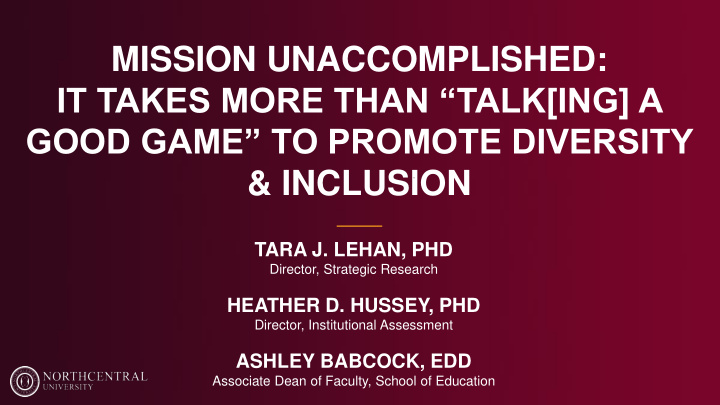



MISSION UNACCOMPLISHED: IT TAKES MORE THAN “TALK[ING] A GOOD GAME” TO PROMOTE DIVERSITY & INCLUSION TARA J. LEHAN, PHD Director, Strategic Research HEATHER D. HUSSEY, PHD Director, Institutional Assessment ASHLEY BABCOCK, EDD Associate Dean of Faculty, School of Education
OBJECTIVES Participants will: • Understand the experiences and perspectives of faculty, staff, and administrators with one or more minoritized identities relating to diversity and inclusion initiatives at their institution • Reflect upon efforts to promote diversity and inclusion at their own institution (see handout) • Understand a model that can be applied at their institution to develop and continuously improve efforts to promote diversity and inclusion (see handout) • List steps they can take at their institution to make meaningful progress in the areas of diversity and inclusion (see handout) 2
ON A MISSION • Increasingly more higher education institutions in the US are including some mention of “diversity” in their mission statements and/or strategic plans • In a recent study of the perceptions and experiences of faculty, staff, and administrators reporting one or more marginalized identities, it was found that few institutions are achieving this mission • “Our mission statement speaks to the need for diversity. I have heard and witnessed a contradiction to this position.” 3
RESEARCH FINDINGS • Fac ulty, staff, and administrators frequently described diversity and inclusion efforts at their institutions as superficial at best and/or misleading at worst • “window dressing” • “lip service” • “just a tagline” 4
RESEARCH FINDINGS •Overall theme: “talk[ ing ] a good game” • Institutional efforts to promote diversity and inclusion almost exclusively included task forces (“of course, because Universities create task forces for everything”), meetings, committees, and trainings • Generally described as narrowly focused and lacking in measurable, observable outcomes 5
RESEARCH FINDINGS • Tunnel vision (narrow view of diversity and Several dynamics inclusion that ignores individuals and groups seemingly are in the periphery) • Playing by others’ rules (lack of associated with representation among and legitimation from perceptions that those in power) diversity and • Uneven playing field (feeling of inclusion efforts powerlessness) • Relegated to the sidelines (marginalization) are mostly talk with • Doing the heavy lifting (completing much of little to no the diversity and inclusion work themselves) meaningful action • Taking a time out (distancing or preparing to leave the institution) 6
PLEASE COMPLETE HANDOUT 1 TO REFLECT UPON EFFORTS AT YOUR OWN INSTITUTION 7
MOVING BEYOND “TALKING A GOOD GAME” • Based on the findings of the previously referenced research involving faculty, staff, and administrators who report one or more minoritized identities, a three- step process was developed • Aim should be to disrupt and dismantle systems of (dis)advantage to promote greater diversity and inclusion 8
Describe the Current State Develop and Define Outcomes Implement a Plan of Interest 9
PLEASE REFER TO HANDOUT 2 FOR MORE INFORMATION ABOUT EACH STEP IN THE PROCESS 10
11
PLEASE COMPLETE HANDOUT 3 TO DEVELOP AN ACTION PLAN THAT YOU CAN COMMIT TO FOLLOWING AT YOUR INSTITUTION CONSIDER POSTING THE COMPLETED HANDOUT WHERE YOU CAN SEE IT REGULARLY AS A REMINDER 12
CONTACT INFORMATION TARA J. LEHAN, PHD TLEHAN@NCU.EDU HEATHER D. HUSSEY, PHD HHUSSEY@NCU.EDU ASHLEY BABCOCK, EDD ABABCOCK@NCU.EDU 13
Recommend
More recommend